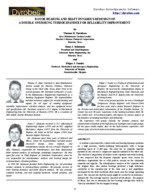Papers
“Rotor Bearing and Shaft Dynamics Redesign of a Double-overhung Turboexpander for Reliability Improvement,” |
Abstract:
A solution is presented for a lateral rotor and bearing dynamics problem on a high pressure, double-overhung turboexpander with a design operating speed of 57,300 rpm. The rotor has an expander impeller mounted at one end and a compressor impeller mounted at the other end. This unit had a long history of failures at the expander-end radial bearing. It was suspected that the frequent expander upsets were caused by unbalance degradation due to solid particle erosion on the aluminum expander-end impeller. The rotordynamics analysis of the expander with the original three lobe journal bearings predicted a high unbalance sensitivity at the expander-end of the rotor and a low logarithmic decrement for the third backward whirl mode near the design operating speed. The concern was that this mode might be excited by an unbalance-initiated rub. The redesign analysis consisted of two phases. The purpose of Phase One was to determine the best bearing redesign that could be “directly substituted” for the original bearings without modifying the shaft or the bearing housing fit diameters and fit lengths. As a backup contingency plan, the Phase Two analysis was pursued while the Phase One retrofit was in operation. The purpose of Phase Two was to find the optimal redesign configuration that would even further improve upon the predicted Phase One retrofit achievements, without the “direct bearing substitution constraint.” This option would include the possibility of a new rotor, new bearings, and possibly a new bearing housing. All objectives were met. The Phase One retrofit ran successfully for over four and one-half years without incident.

